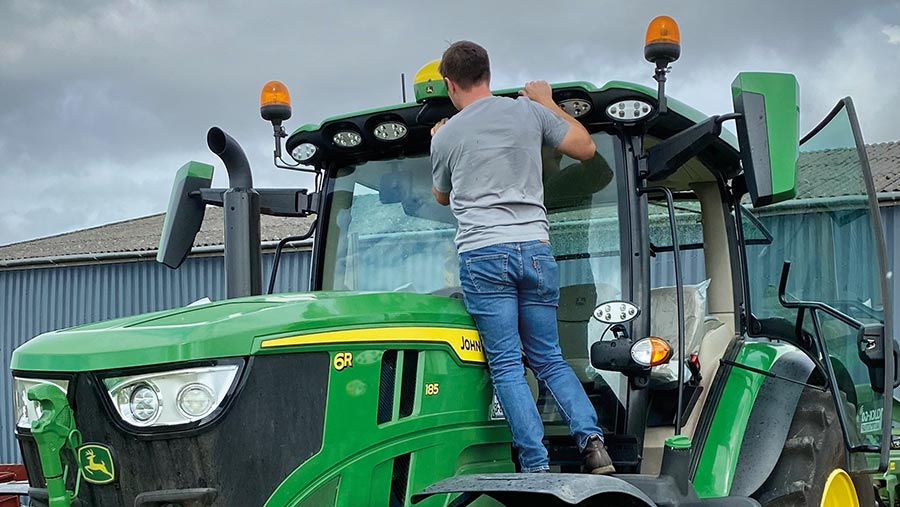Retrofit tracker launched to find stolen Starfire receivers
 © MAG/Oliver Mark
© MAG/Oliver Mark Cambridgeshire firm Traakit has adapted a regular GPS tracker for use in John Deere’s Starfire 6000 receiver, allowing it to be followed and recovered if stolen.
Its launch is timely, with NFU Mutual reporting a surge of equipment thefts, up 30% in the first quarter of this year, and thieves likely to take advantage of spring fieldwork to identify fresh targets.
See also: Video: How one farm has beefed up security after GPS theft
The TD3 black box is stashed covertly within the Starfire dome so there’s no indication that it is inside.
And thanks to a built-in battery, the device can send regular location updates for police to pursue should the device be pilfered.
While static, it will ping its whereabouts twice a day, but that is automatically reduced to two-minute intervals once a theft is confirmed.
It has enough power capacity to survive for at least three days without charge, and is replenished from the tractor’s electrical circuit whenever the receiver is on the roof and plugged in.
The device is disarmed all the time it is connected to the tractor with the ignition on.
When it stops charging, the theft detection system is automatically armed and the registered owner will be alerted, within minutes, to any movements.
This might cause the odd minor inconvenience, most notably in that removing the dome from the tractor’s roof to tuck it away for the night will instigate an almost immediate call from the third-party operations centre.
They simply need to be told that all is well.
What if it is stolen?
The same process applies if the receiver has been nobbled.
After confirming that to be the case, the owner (or secondary contact, should the owner be deep in slumber and unreachable) must report it to the police, calling 999 if it’s deemed to be a crime in progress.
The resulting crime reference number can then be passed to the operations centre, which will liaise directly with the local force to track down the stolen item.
The potential weak link here is the ability of the police to put up a meaningful chase.
Unlike most ATV trackers, farmers are not given access to the mapping system. Instead, it’s purely a burglar alarm, ostensibly eliminating the risk of anyone heading out in hot pursuit.
Time tends to be of the essence, says Traakit’s Tim Young, with the perpetrators often getting stolen wares out of the country within eight hours.
Once the kit is stashed in a container the game is likely up, as the little antenna simply won’t be able to sniff out adequate satellite signal to function.
Does the tracker work with other receivers?
Traakit is only offering the kit for Starfire 6000 units.
Primarily, this is because they have a void big enough to accommodate the tracker – though the 6000s also happen to be particularly popular among farmers and, therefore, thieves too.
The system can’t be adapted for use with the Starfire 3000 – it simply won’t fit – and nor, currently, for receivers from other brands. The company is yet to determine the suitability of the Starfire 7000.
How much does it cost?
Each device is priced at £285, and subject to an annual subscription of £130. This includes 24-hour support from the operations centre.
For anyone buying five or more, the upfront cost drops to £260 and each subscription is £110.
These figures include a fitting service anywhere in the UK.
It is a relatively simple job involving a spot of soldering and not much else, and the process doesn’t involve any material changes to the original dome.
But owners of John Deere guidance systems may well be peeved about the irony of having to shell out more money for a third-party tracker that provides the GPS co-ordinates of a GPS system.
A Cambridgeshire farmer who has tested the Traakit also points to the “absurdity” of having the dome painted bright yellow to be seen by anyone passing on the road.
He intends to repaint his to make it less conspicuous and overtly mark it to reduce its appeal.
Deere insists it is making progress on guidance security. Relatively recent updates include pin-code protection – though critics claim it can be circumnavigated by hackers – and the option of having the receiver built into the roof on some models.
But, in doing so, it means the technology can’t be switched between machines and it doesn’t necessarily eliminate the problem either, with stories of thieves butchering cabs, smashing windows and hacking at wires to get what they want.

